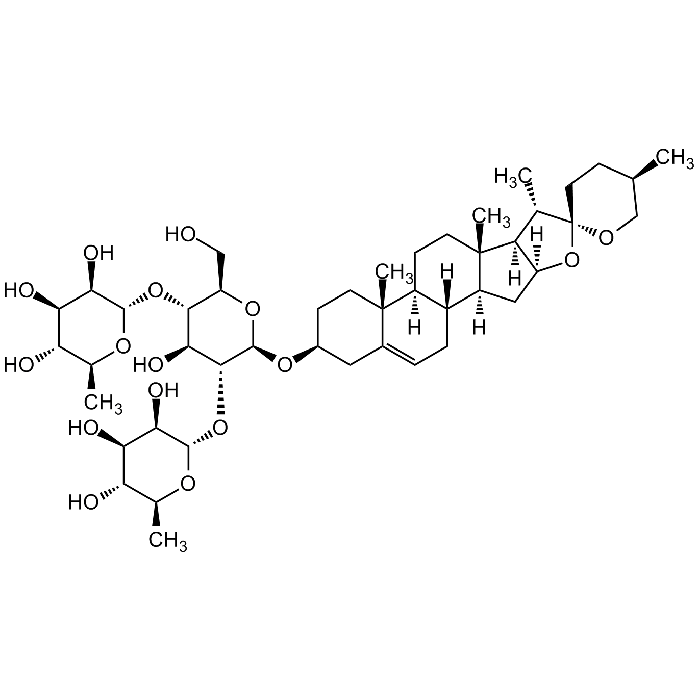Cookie Policy: This site uses cookies to improve your experience. You can find out more about our use of cookies in our Privacy Policy. By continuing to browse this site you agree to our use of cookies.
Chemodex
Dioscin

| Product Details | |
|---|---|
| Synonyms | Collettiside III; Polyphyllin III; CCRIS 4123 |
| Product Type | Chemical |
| Properties | |
| Formula |
C45H72O16 |
| MW | 869.04 |
| CAS | 19057-60-4 |
| Source/Host Chemicals | Plant |
| Purity Chemicals | ≥98% (NMR) |
| Appearance | Wthie to off-white powder. |
| Solubility | Soluble in DMSO (10mg/ml), DMF (10mg/ml) or ethanol (5mg/ml). |
| Identity | Determined by 1H-NMR. |
| Declaration | Manufactured by Chemodex. |
| Other Product Data |
Click here for Original Manufacturer Product Datasheet |
| InChi Key | VNONINPVFQTJOC-ZGXDEBHDSA-N |
| Smiles | C[C@H](CC1)CO[C@]21O[C@@]3([H])C[C@@]4([H])[C@]5([H])CC=C6C[C@@H](O[C@H](O[C@@H]7CO)[C@H](O[C@H]8[C@H](O)[C@H](O)[C@@H](O)[C@H](C)O8)[C@@H](O)[C@@H]7O[C@@H]9O[C@@H](C)[C@H](O)[C@@H](O)[C@H]9O)CC[C@]6(C)[C@@]5([H])CC[C@]4(C)[C@@]3([H])[C@@H]2C |
| Shipping and Handling | |
| Shipping | AMBIENT |
| Short Term Storage | +4°C |
| Long Term Storage | +4°C |
| Handling Advice | Protect from light and moisture. |
| Use/Stability | Stable for at least 2 years after receipt when stored at +4°C. |
| Documents | |
| Product Specification Sheet | |
| Datasheet |
 Download PDF Download PDF |
Dioscin is a natural steroid saponin originally isolated from plants used in herbal remedies. It has anticancer, anti-inflammatory, immunoregulatory, antioxidant, hyoplipidemic, antiviral, neuroprotective and antifungal activities. It inhibits proliferation, induces autophagy and oxygen-mediated apoptosis in cancer cells. It has been shown to inhibit colon tumor growth and tumor angiogenesis through regulating VEGFR2 and AKT/MAPK pathways. It inhibits adipogenesis through the AMPK/MAPK pathway. Dioscin showed protective effect against liver fibrosis by potently inhibiting ITGA5. Promotes proliferation of pancreatic beta cells via Wnt/β-catenin signaling pathways. It has been shown inhibit the nuclear transport of NF-κ and the expression of reactive oxygen species (ROS) and consequently the expression of inflammasome targets such as NLRP3. Potent inhibitor of Skp2, component of the ubiquitin/proteasome degradation pathway.
(1) J. Cai, et al.; Biol. Pharm. Bull. 25, 193 (2002) | (2) Z. Wang, et al.; Cancer Biol. Ther. 13, 138 (2012) | (3) J. cho, et al.; Biochim. Biophys. Acta. 1828, 1153 (2013) | (4) M.J. Hsieh, et al.; Arch. Toxicol. 87, 1927 (2013) | (5) L. Lv, et al.; Food Chem. Toxicol. 59, 657 (2013) | (6) B. Poudel, et al.; Int. J. Mol. Med. 34, 1401 (2014) | (7) S. Wu, et al.; Biochimie 110, 62 (2015) | (8) M. Liu, et al.; Sci. Rep. 5, 7973 (2015) | (9) L. Xu, et al.; Food Chem. Toxicol. 107, 318 (2017) | (10) F. Yu, et al.; Clin. Lab. 64, 785 (2018) | (11) X. Tao, et al.; Pharmacol. Res. 137, 259 (2018) (Review) | (12) Y. Qi, et al.; Molecules 24, E1247 (2019) | (13) L. Yang, et al.; Biomed. Res. Int. 2019, 5763602 (2019) (Review) | (14) W. Yin, et al.; Small 16, e1905977 (2020) | (15) W. Jiang, et al.; EBioMedicine 51, 102593 (2020)





